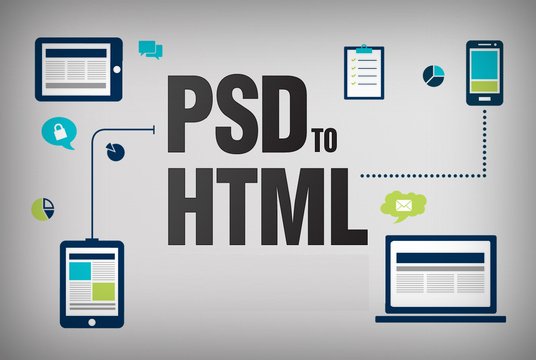In the fast-evolving world of web development, creating visually appealing and responsive websites is essential for businesses looking to establish a strong online presence. One of the most reliable and widely-used processes in web development is converting PSD (Photoshop Design) files into HTML. This method ensures that custom website designs are transformed into fully functional, cross-browser-compatible, and mobile-responsive web pages. PSD to HTML development services are highly sought after in the USA, where precision, performance, and user experience are critical factors for success.
What Is PSD to HTML Conversion?
PSD to HTML conversion refers to the process of converting a website layout designed in Adobe Photoshop (or a similar tool) into HTML (HyperText Markup Language) code. It typically involves slicing the PSD design into different components, writing clean HTML and CSS (Cascading Style Sheets) code, and sometimes integrating JavaScript for dynamic functionality. This ensures that the design looks consistent across various devices and browsers while maintaining fast performance and ease of navigation.
Why Choose PSD to HTML Development Services?
PSD to HTML conversion is vital for businesses that prioritize a unique and custom design for their websites. It provides several benefits that make it the preferred choice for web development:
1. Pixel-Perfect Design Conversion: The primary objective of PSD to HTML conversion is to ensure pixel-perfect design accuracy. This means that the final web pages will exactly match the original Photoshop designs, providing a seamless transition from design to development. By adhering to exact specifications, businesses can maintain their brand identity and visual appeal.
2. Responsive Web Design: In today’s mobile-first world, it is essential for websites to function smoothly across all devices, including smartphones, tablets, and desktops. PSD to HTML services in the USA focus on creating responsive designs that automatically adapt to different screen sizes, ensuring a consistent user experience on all platforms.
3. Cross-Browser Compatibility: With numerous web browsers available, ensuring that a website works consistently across all platforms is critical. PSD to HTML developers in the USA utilize modern coding techniques and rigorous testing to ensure cross-browser compatibility, making the website accessible to users regardless of their preferred browser (Chrome, Firefox, Safari, Edge, etc.).
4. SEO-Friendly Code: SEO (Search Engine Optimization) plays a significant role in a website’s visibility on search engines like Google. PSD to HTML development services in USA ensure that the code is SEO-friendly by following best practices such as semantic HTML coding, optimized images, and clean, well-structured code. This improves the website’s ranking potential and helps drive organic traffic.
5. Fast Loading Times: A website’s speed is crucial for user retention and search engine ranking. During PSD to HTML conversion, developers optimize the code, images, and other media files to ensure fast loading times. This helps in providing a smooth browsing experience, reducing bounce rates, and improving customer satisfaction.
6. W3C Validation: Web standards are important for ensuring the quality and longevity of a website. PSD to HTML conversion services in the USA follow W3C (World Wide Web Consortium) guidelines, ensuring that the code is valid, error-free, and adheres to international web development standards. This improves the website’s performance and future compatibility with new web technologies.
PSD to HTML Development Process
The PSD to HTML development process is structured and involves several critical steps to ensure that the final website is high-performing and visually aligned with the design. Here’s a breakdown of the typical steps involved:
1. Slicing the PSD File: The first step in the PSD to HTML conversion process is slicing the PSD file into smaller components such as headers, footers, images, and buttons. This makes it easier to apply the necessary HTML, CSS, and JavaScript to each section while maintaining the integrity of the design.
2. Creating HTML Markup: After slicing the design, developers start writing the HTML markup for each component. HTML is responsible for structuring the content of the website. During this stage, developers ensure that the HTML code is clean, semantic, and follows best practices for accessibility and SEO.
3. Styling with CSS: Once the HTML markup is in place, CSS is used to style the web pages. This includes applying colors, fonts, spacing, and layout to match the original PSD design. CSS frameworks like Bootstrap or custom CSS code can be used to enhance the design and make the site responsive.
4. Adding Interactive Features with JavaScript: For websites that require dynamic functionality, such as animations, sliders, or interactive forms, JavaScript is used. JavaScript frameworks like jQuery or React can also be integrated to enhance user interactions and improve the overall user experience.
5. Testing for Responsiveness: After coding, developers rigorously test the website for responsiveness across various devices and browsers. Tools like Google’s Mobile-Friendly Test or BrowserStack are often used to ensure that the design looks great and functions well on smartphones, tablets, and desktops.
6. Testing for Cross-Browser Compatibility: Developers perform cross-browser testing to ensure that the website works consistently on major web browsers. This helps prevent issues that can arise due to differences in how browsers interpret code.
7. Final Quality Assurance and Delivery: Before delivering the final product, developers conduct a thorough quality assurance (QA) process. This involves checking for any coding errors, broken links, or bugs, and ensuring the overall functionality and performance of the site. Once the QA phase is complete, the website is ready for launch.
PSD to HTML Development Services in the USA
In the USA, PSD to HTML development services are widely available, catering to a variety of industries, including e-commerce, education, healthcare, and corporate businesses. These services typically include:
- Custom Website Development: Tailored solutions based on unique PSD designs, ensuring the website aligns with business goals and brand identity.
- Responsive and Mobile-Friendly Conversion: Ensuring websites are fully optimized for all screen sizes and devices.
- Cross-Browser Testing: Rigorous testing to ensure the website performs flawlessly across different browsers and platforms.
- SEO-Optimized Code: Developers create clean, well-structured code that is SEO-friendly, helping improve search engine rankings.
- Post-Launch Support and Maintenance: Providing ongoing support to address any issues, update features, and maintain the website’s performance.
The Future of PSD to HTML in the USA
With the increasing importance of user experience, performance, and visual aesthetics, PSD to HTML conversion remains a vital service in the USA’s web development landscape. As new design and development trends emerge, including advancements in HTML5, CSS3, and JavaScript frameworks, the demand for high-quality, responsive, and SEO-friendly websites will continue to grow.
In conclusion, PSD to HTML development services in the USA provide businesses with a powerful way to bring custom designs to life. By converting visually stunning PSD files into fully functional HTML code, developers ensure that websites are not only attractive but also responsive, secure, and optimized for performance.



